Mushrooms are delicious. But they also don’t stay fresh for very long. Freezing is a good option if you’ve got a surplus of mushrooms that you want to save for later.
Can you freeze mushrooms? Yes, you can! Mushrooms can be frozen raw. But for better texture, it’s recommended to blanch or sautee them first. Individually freezing them on a tray before bagging them up will prevent them from clumping together, which will allow you to thaw only what you need at a time.
Mushrooms are a delicious and nutritious addition to meals that bring a lot of extra flavor. But a certain process needs to be followed when freezing them if you want to get the best results.
In this article, I’ll teach you various methods for freezing mushrooms. Including using raw, steamed, and sauteed mushrooms. I’ll also explain how to dry or pickle mushrooms if you’re running low on freezer space.
How To Freeze Mushrooms

There are a few reasons why you might want to freeze mushrooms.
Maybe you found a great deal at a supermarket that seemed too good to pass up, so you bought several pounds of mushrooms.
Perhaps you’ve been foraging for wild mushrooms and found a plentiful bounty of wild morels and chanterelles.
When foraging a wild mushrooms make sure you identify them before freezing. If you are novice you can doubt between a toadstool and edible mushroom.
Or you might have tried your hand at growing mushrooms of your own, and produced way more mushrooms than you expected!
No matter what your reason is, if you won’t be able to use all of your mushroom supply before it starts to go bad, then freezing them is a great way to keep them and avoid having to throw them away.
Fresh mushrooms will only stay fresh in the refrigerator for about a week. So if you don’t think you’ll be able to eat them all within that timeframe, it’s good to plan ahead and start thinking about freezing some of them.
It’s best to freeze mushrooms while they’re still as fresh as possible. If you freeze shriveled and dried out mushrooms that are a day or two away from going bad, that’s how they’ll be when you thaw them out again too.
So pick mushrooms that look and smell fresh to put in your freezer. Toss any that are already developing dark spots.
When you’re buying mushrooms, look for a fresh and woodsy smell. They shouldn’t smell moldy or musty. Their texture should be firm, not flaky. They shouldn’t look discolored or bruised.
For larger mushrooms, try to find ones with gills that are still closed and not black when you’re buying them.
In the short term before you can freeze them, store them in the refrigerator in a paper bag to absorb any excess moisture they release.
Or if they come pre-wrapped from the grocery store, you can keep them as-is until you’re ready to freeze them.
Read my article How long do mushrooms last to know how to store them and when they’ll start to go bad.
Cleaning Your Mushrooms
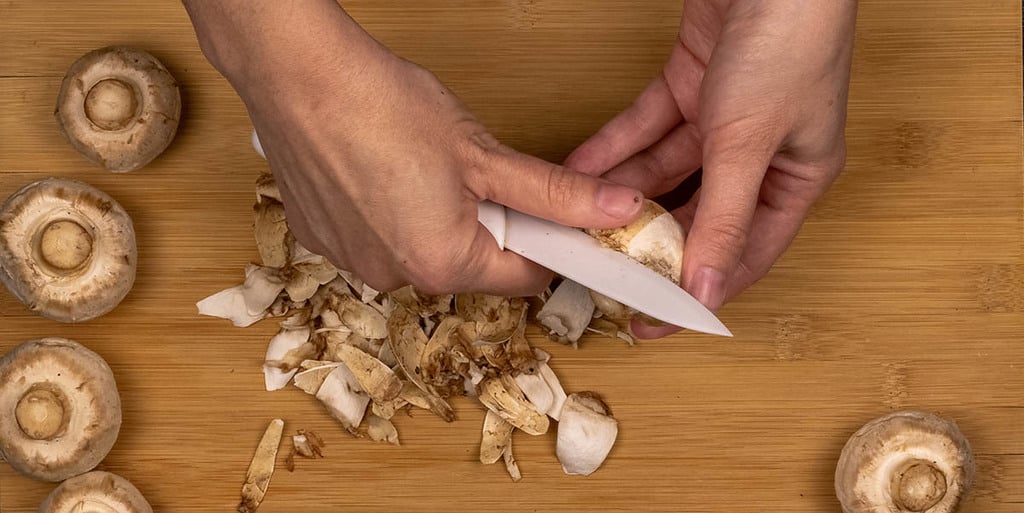
No matter how you freeze your mushrooms, you’re going to want to clean them first. It will be nearly impossible to remove any dirt or other impurities from your mushrooms once they’ve been frozen.
So you want to freeze them in a state that they’re ready to add right to a pot or pan without any additional work.
Most cooks will tell you to avoid washing mushrooms. Mushrooms tend to absorb a lot of moisture, which can leave them mushy and soggy.
Instead, use a coarse brush to remove as much visible dirt as possible. You can also trim the ends of the stems off, as these tend to be tough and woody, and usually aren’t eaten anyways.
Freezing Mushrooms Raw
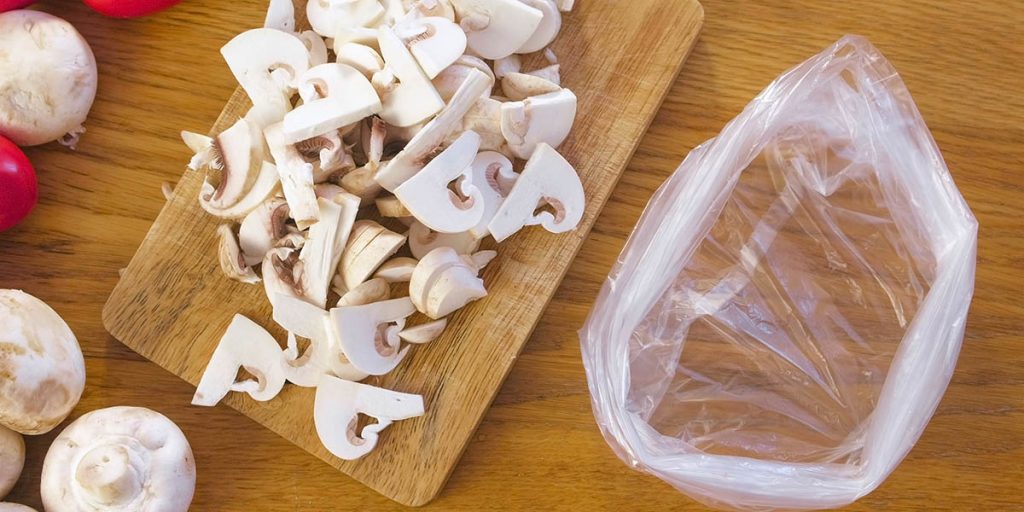
The simplest way to freeze your mushrooms is just to freeze them raw without any additional preparation. You can either chop them into slices or freeze them whole.
You can simply throw mushrooms into a freezer bag, but this won’t yield the best results.
Instead, lay mushrooms out on a tray lined with parchment paper and slide the entire tray into the freezer. This will individually flash freeze them.
Then you can take the frozen mushrooms out and put them in freezer bags. Try to remove as much excess air from the bags as possible.
Drier mushrooms like maitake (hen of the woods) freeze better raw than more moist varieties.
Raw frozen mushrooms are best if you want to use them in soups, casseroles, or stews.
Basically any dish where the mushrooms won’t be the main stars, and where consistency doesn’t matter as much. Since mushrooms are mostly made of water, they tend to get mushy when you freeze them raw.
The taste will still be great, but the texture may leave something to be desired if you eat them as-is.
Luckily there are some other techniques you can use before freezing to create better results.
The ones below will result in more versatile frozen mushrooms that you’ll be able to use in your kitchen in a wider variety of ways.
Blanching or Steaming Your Mushrooms Before Freezing
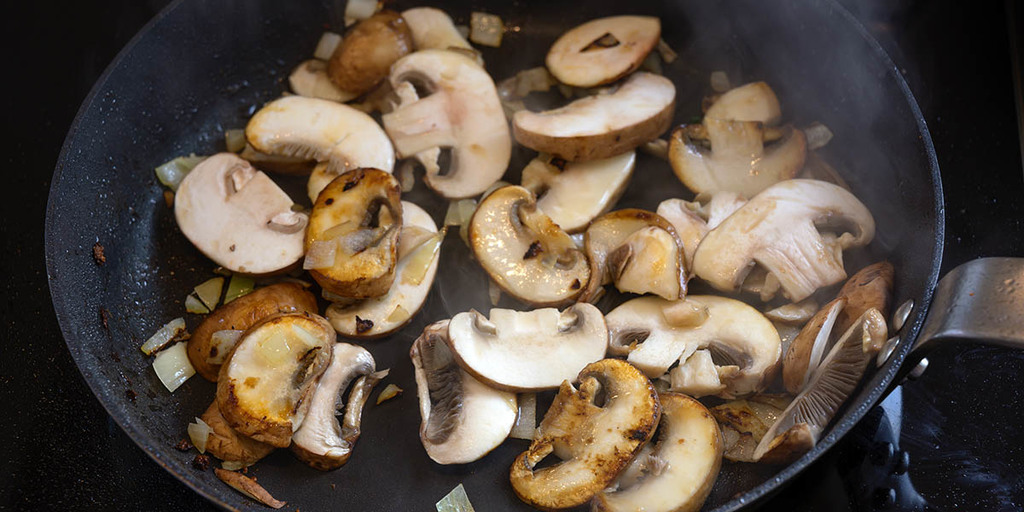
Blanching is partially cooking your mushrooms using steam before you freeze them.
The amount of time it will take to blanch your mushrooms will depend on their size. So it’s best to sort your mushrooms by size first.
You don’t have to sort them exactly, but try to separate out the larger and smaller mushrooms into separate groups.
For mushrooms that are bigger than an inch across, you’ll want to cut them into quarters or slice them up, as a quick blanching won’t cook them all the way through.
TIP: You can prevent mushrooms from turning a darker color when blanching by first soaking them in a solution of 1 teaspoon lemon juice per 2 cups of water.
When you’re ready to blanch your mushrooms, place them in a steamer basket and place them above a pot of boiling water.
Whole mushrooms will take about five minutes to blanch. Smaller button mushrooms, or mushrooms that you’ve cut into quarters or slices, will take about three minutes.
After you’ve steamed your mushrooms, plunge them into a bowl of ice water for the same amount of time that you steamed them for.
Then strain as much of the water off as you can, and seal them into airtight containers or freezer bags. Removing as much air as you can will help to prevent freezer burn.
Blanched or steamed mushrooms won’t be as soggy and mushy when you thaw them out compared to mushrooms that have been frozen raw.
They’ll go great on top of a pizza, or in a quiche or pasta dish. They’ll have the best flavor if you use them within a year of freezing them.
If you’re adding frozen blanched mushrooms to a stirfry, try to only add a couple at a time. This will prevent cooling the pan down too much.
For dishes that you’re putting in the oven, mushrooms can typically be added while they’re still frozen. They’ll thaw and heat up in the oven while the rest of the ingredients are cooking.
For foods like soup or stews that aren’t going in the oven, toss your frozen mushrooms in about twenty minutes before the recipe is done cooking.
Read more in my article How to cook mushroom the right way before you start cooking.
Sauteeing Your Mushrooms Before Freezing

Sauteeing is cooking your mushrooms in a little bit of butter or hot oil before freezing them. You can also add any other seasonings like salt and pepper that you desire while sauteeing them.
Although I prefer to keep them more plain, so they can be used in any recipe.
Sauteed mushrooms will keep a firmer texture than either blanched or raw mushrooms, and is my preferred way to prepare them before freezing.
You can use them in all the ways you’d normally use mushrooms like on pizza, in a stroganoff dish, stir fries, quiches, stews or other recipes. Check these 25 Of The Best Vegan Mushroom Recipes if you are vegan.
Either whole or sliced mushrooms will take about four minutes to sautee. You want to get them almost fully cooked, but not quite all the way. Most of the liquid should be evaporated from the pan when they’re done.
Allow sauteed mushrooms to cool down on a plate lined with paper towel until they get to near room temperature.
Then you can pack them into containers or airtight bags, and try to get as much air out of your container as possible to keep them fresh.
Just like raw mushrooms, you can also individually quick freeze your mushrooms that have been sauteed.
Lay your mushrooms out on a tray lined with parchment paper and freeze, then place them into freezer bags once they’re frozen. You can lift them with a spatula if they’ve stuck to the parchment paper at all.
If you don’t individually freeze your mushrooms before packing them, leave about half an inch of air space at the top of any containers, as the mushrooms may expand a bit when cooled.
I would highly recommend individually freezing your mushrooms, otherwise you can end up with a big solid clump if they all freeze together.
You want to be able to thaw out only what you need, instead of having to remove a whole brick of mushrooms from your freezer.
Use sauteed mushrooms within nine months of freezing.
Other Ways You Can Preserve Mushrooms
If you’ve run out of freezer space, you do have a couple of other options for preserving any excess mushrooms that you’ve got.
1. Drying Your Extra Mushrooms
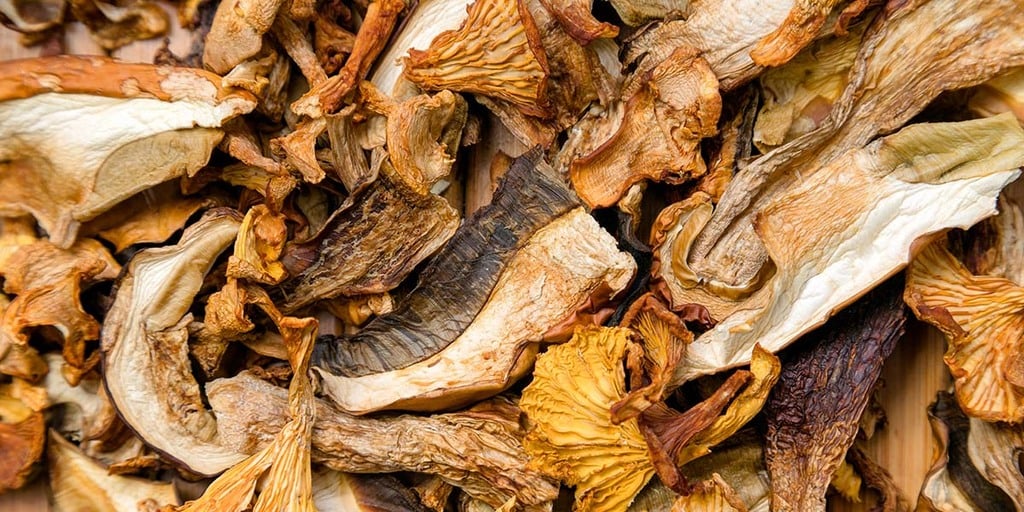
Drying mushrooms is another great way to preserve them for use in the future.
Using a low heat is best to preserve the meat-like umami flavor of the mushrooms. If you have a food dehydrator, set it to about 45 degrees C (113 degrees F.)
If you haven’t got a dehydrator, you can try setting your oven to a similar temperature, or as low as it can go, and dry the mushrooms out with the door cracked open to let the excess moisture easily escape.
Either way, it will take between six and twelve hours for your mushrooms to be fully dehydrated. If you want to dry them out a little quicker, you can turn the heat up a bit higher.
But I wouldn’t exceed 50 degrees C (122 degrees F.) If you use too high of a heat, the mushrooms will lose most of their flavor.
To dry your mushrooms out, you’ll need to cut them very thin. About 1/4 inch to 1/2 inch (0.6 to 1.3 cm) will work best. Any thicker and it may be difficult to get all of the moisture out.
Cut them as evenly as possible, because the thinner pieces will dry out faster than the thicker ones. If there’s too much difference you’ll have to gradually pull out thinner dried ones to avoid having them start to burn.
Some mushrooms are harder to cut evenly than others. If you can’t get them even, try to at least sort different sizes into different areas of the tray or separate trays.
Just like with freezing your mushrooms, give them a good scrub with a brush first to get most of the dirt off the mushroom’s surface first. Then pat them dry with a paper towel before slicing them.
Start checking for dryness at around the six hour mark. Take out any that are fully dried. They should snap in half when you try to bend them and feel crispy.
Keep checking on any that aren’t yet dried every 30 minutes or hour.
Once you remove dried mushrooms from the oven or dehydrator, let them sit and cool on the countertop at room temperature for about an hour, or until they’re completely cool when you touch them.
If any of the cooled mushrooms still seem bendable or moist, put them back in to continue drying.
Once the dried mushrooms are cool, you can store them in an airtight bag or a glass jar with an airtight lid. Keep your mushrooms in a cool dark place, and they should stay fresh for between 6 months and a year.
You’ll know that they’re no longer good if they start to lose their mushroom scent.
When you want to rehydrate your dried mushrooms, put them in a bowl and pour boiling water over them. Then let them soak for around twenty to thirty minutes.
Dried mushrooms make a great addition to sauces and soups.
2. Pickling Your Extra Mushrooms
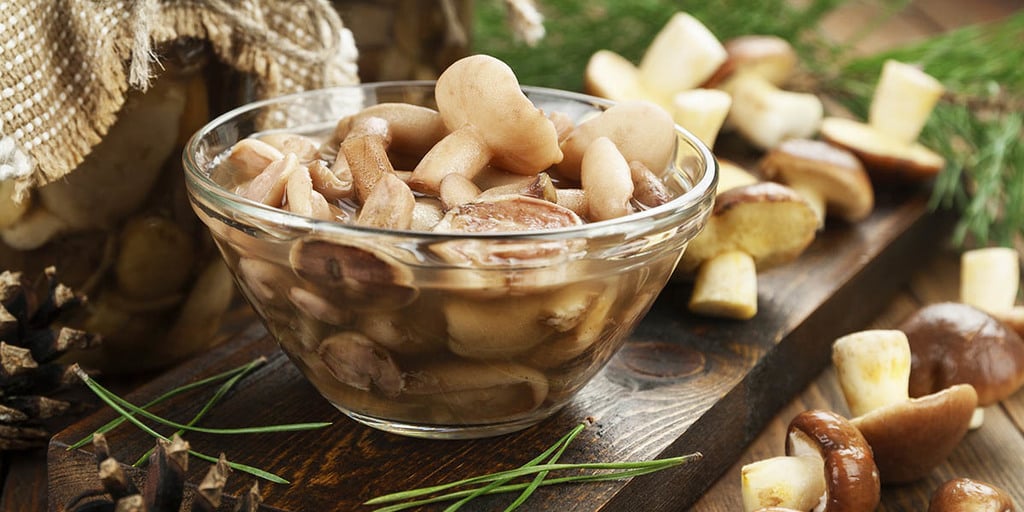
One less conventional way to preserve mushrooms that you probably didn’t think of is to pickle them.
Just like cucumbers or eggs, you can pickle mushrooms to keep them for longer, and they’ll have a great, slightly sour taste.
Start by cleaning any dirt off your mushrooms. You can wash them under cool water since they’ll be sitting in liquid anyway. Larger mushrooms can be sliced into quarters or halves, or you can leave smaller ones whole.
Button mushrooms are small enough to pickle whole, but larger cremini or portobello mushrooms will probably need to be sliced.
Start the pickling process by gathering some herbs like bay leaves, thyme, oregano, dill, rosemary, or garlic.
You’ll also want to get 1 liter (1 quart) mason jars that can stand extreme temperature changes. You’ll also need your jars to have lids that you can seal airtight.
Get a non-reactive saucepan (made of stainless steel, glass, or ceramic) and pour in 180 ml of water and 89 ml of white vinegar.
Avoid using cast iron, copper, or aluminum pans. These will give your pickles an offputting metallic taste.
Add your desired amount of spices to the brine, as well as about 1 tbsp of salt and 1 tbsp of black pepper.
Put your mushrooms into the brine and bring the whole mixture to a boil over high heat. Then reduce your heat and let the mixture simmer for about fifteen minutes.
After fifteen minutes, take the mixture and pour it into a pickling jar. Do this slowly to avoid burning yourself.
You might want to use a spoon to transfer the mushrooms so they don’t splash when they fall into the jar. Use a slotted spoon to get any herbs left in the pan and add them to the jar too.
Let the mixture cool at room temperature from around 30 minutes to an hour. Then place your airtight lid on your jar and place it into the refrigerator.
The temperature difference will seal the jar and keep things fresh.
Wait about three days for your pickled mushrooms to absorb all of the spices and vinegar in the jar before giving them a try. Your jar will stay good in the fridge for at least a month.
Conclusion
Mushrooms can be frozen to keep them preserved, if you won’t be able to use them fresh within a week or so. Pick fresh mushrooms to freeze.
If you put iffy mushrooms into the freezer, you’ll get iffy mushrooms back when you thaw them out again.
You can freeze mushrooms raw if you plan to use them in soups. But it’s better to blanch (steam) or sautee them. That way they’ll retain a better texture for use on pizzas, in pasta, or other recipes.
For more inspiration, we collect 30 Of The Best Mushroom Recipe Ideas that definitely worse to try cooking.
If you aren’t able to freeze your mushrooms, dehydrating them or pickling them are also good options to consider.
With all of these options, there’s no excuse to let your fresh mushrooms go to waste any longer!
If you still have questions or want to learn more about mushrooms, read my articles below:
